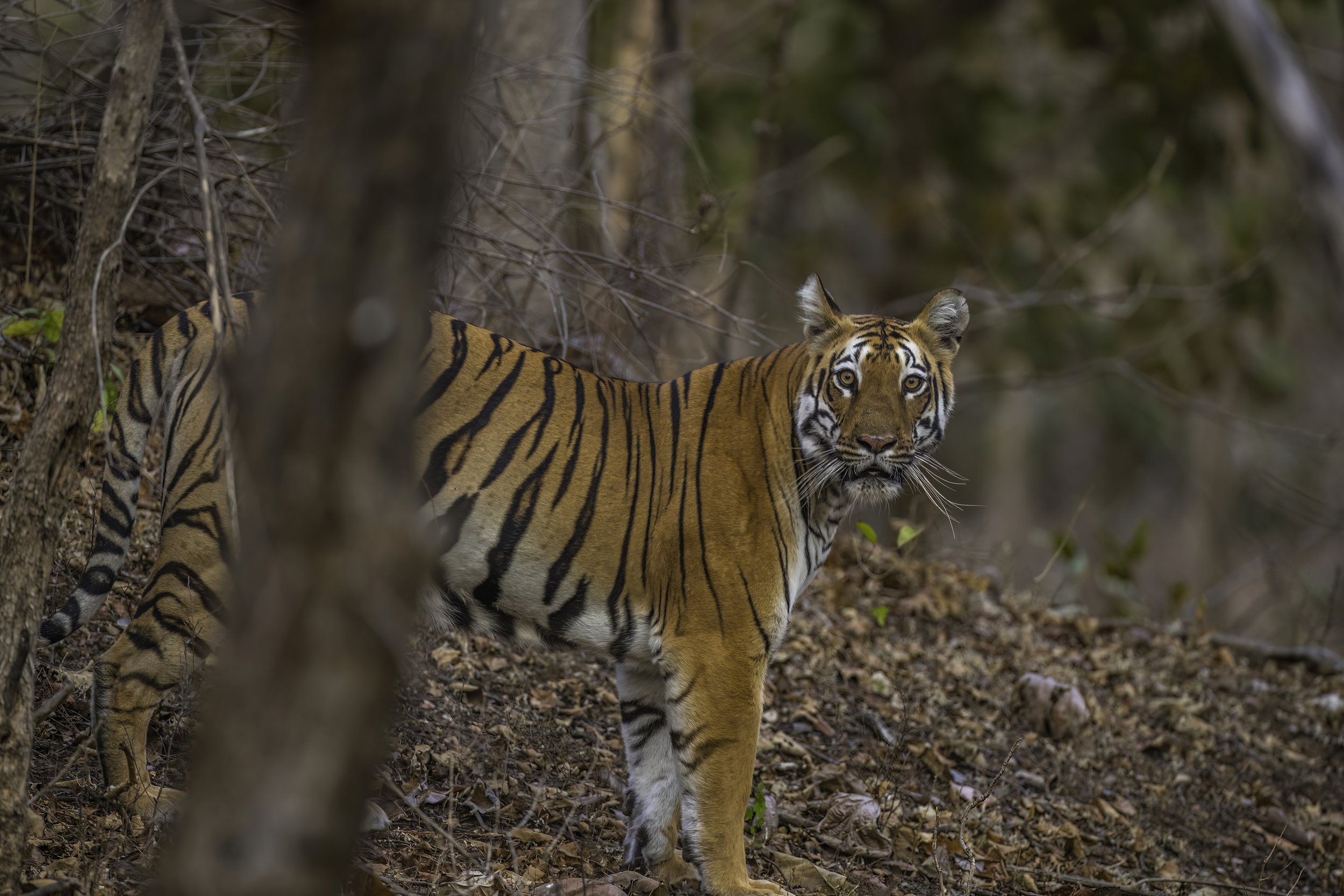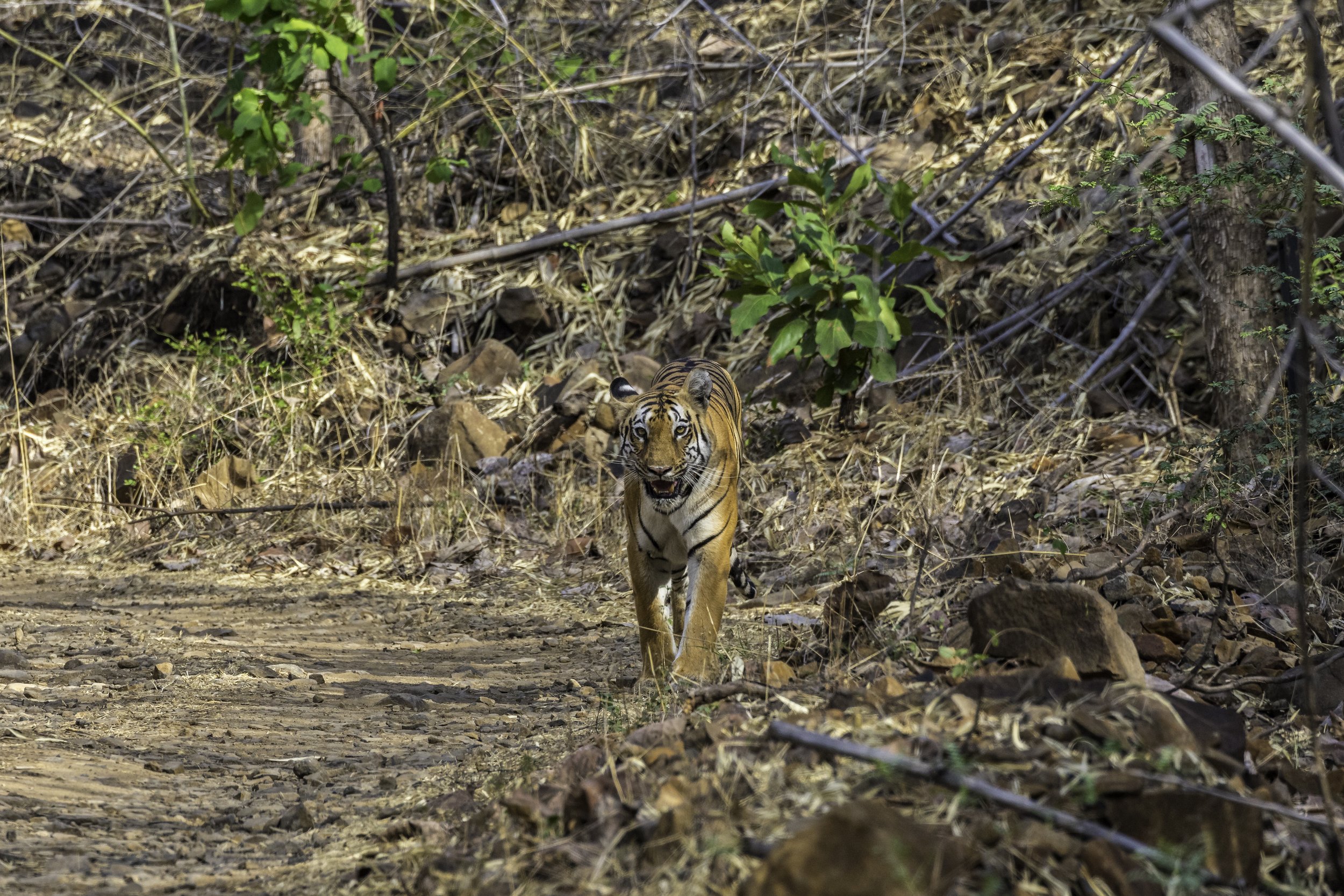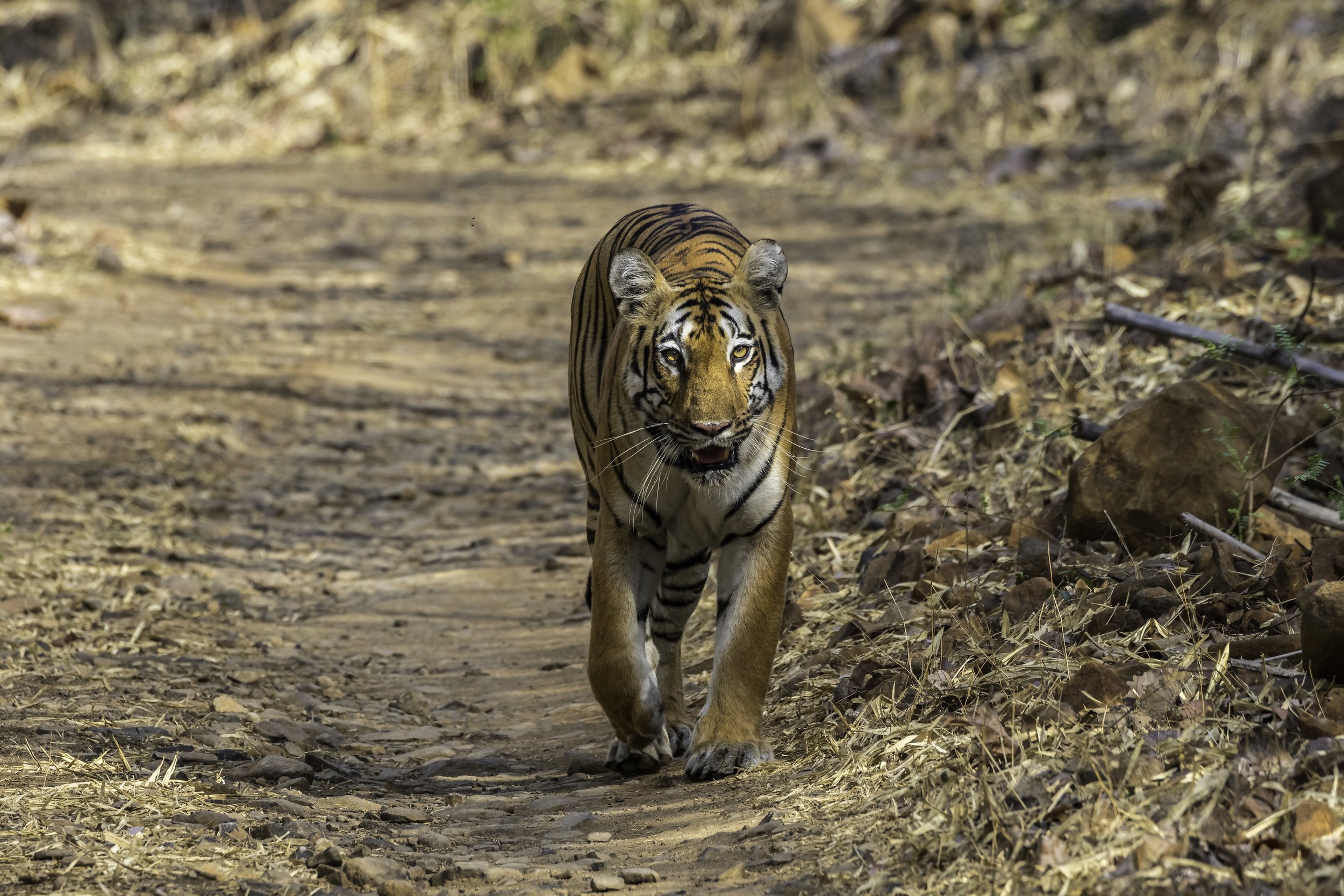Meadow queen of Maregaon
The “4“ Mark tigress of Tipeshwar
Panthera tigris tigris
ENDANGERED
Tipeshwar Wildlife Sanctuary, Maharashtra
Every wildlife enthusiast, at some point, dreams of spotting a royal bengal tiger in the wild and there is no better place than in India with its numerous tiger sanctuaries of varying climes and terrain. This is my experience with the Meadow queen of Maregaon, also called the “4” Mark tigress because she has a huge “4“ beside her right eye.
“4” Mark was born in November 2013 to the Pilkhan female and the powerful Budha male. She was the second of three cubs, the other two being Zara & Zarina (X-Mark & H-Mark). But before we get into that let me put it in context of the habitat.
By the 1990s, much of the tiger population in India was wiped from almost all the wildlife reserves due to the exponential increase in human settlements inside and on the fringes of the forests. This led to a fragmentation of the forests and a breakdown of the corridors connecting the forested areas. One such fragment was the still relatively unknown Tipeshwar Wildlife Sanctuary, an isolated national park in the Yavatmal area along the borders of Telangana and Maharashtra. It lies in the Pandarkawada district of Yavatmal and stretches over an area of 148.63 sq.kms sprawling among the Patanbori and Parwa ranges of the Pandarkawad Forest Division. The sanctuary is a compact patch of dense forest cover with hilly undulating territory and various types of vegetation that varies with the altitude. It derives its name from the "‘Goddess Tipai” who is enshrined in a tiny temple on the hillside near the Tipeshwar Village within the sanctuary area just about 2kms from the Tipeshwar Forest Guest House.
Tipai Mata Temple
Tipeshwar Wildlife Sanctuary
Tipeshwar Wildlife Sanctuary has emerged as a successful tiger-cradle in the Eastern Vidarbha Landscape (one of the prominent Tiger Conservation Landscapes of India) and has demonstrated the potential to populate nearby tiger reserves like the Kawal Sanctuary in Telangana. However, like almost all other tiger reserves in India, Tipeshwar too, is plagued by the usual suspects – it is surrounded by densely populated and human dominated landscape with all the associated baggage that unhindered human activity brings - poaching, cattle grazing, trespassing etc., development – illegal mining, highway expansion etc., forest and prey-base degradation, human-tiger conflict etc. There are also a number of villages within the sanctuary area and their inhabitants are dependent on the forest for their livelihood.
But that said Tipeshwar has gone from being a sink, collecting surplus tigers from the larger sanctuaries, to becoming a source, generating increasing tiger numbers with village relocation playing a particularly important part. The three villages in the sanctuary - Tipeshwar, Pitapingri and Maregaon - mostly dominated by the Kolam tribe were relocated, I think, in 2014-15.
Five tribes occupy the Tipeshwar forest region viz., Pardhan, Gond, Kolam, Navbuddha & Kunbi, of which the former three are said to be aboriginal. The total populations of these tribes range from a few hundred to thousand and are seemingly vanishing; these tribes are stricken with poverty with a high mortality rate in infants, and a high incidence of sickle cell disease. Albeit in the recent years the increase in tourism has improved their condition to some degree.
The inviolate spaces created for the tigers through this village relocation exercise and additional measures such as the introduction of prey like sambar has helped the increase in the population of tigers. Seen below is the “4” Mark female just after we first spotted her and as she gracefully made her way towards us.
The Tipeshwar Sanctuary is also home to a number of rivers like Purna, Krishna, Bhima and Tapti which irrigate the sanctuary. This abundance of water gives the region the moniker - the Green Oasis of Maharashtra. The sanctuary area is primarily composed of basalt from some ancient lava eruptions and boasts immense diversity in both flora & fauna.
It is home to some 25 species of mammals, about 182 species of birds, 22 species of amphibians and numerous reptiles like the Indian Cobra, Indian Rock Python, Russel’s Viper & Checkered Keelback. And of these multitude of reptiles 6 are scarce species. Bengal Tigers, Leopards, Sloth Bears, Indian leopards, Gaur, Dhole, Hyena, Chital, Black Buck, Sambar, Jackal, Wild boar, Peacock, Hanuman Langur, Nilgai & Wild Cats like the Jungle Cat are some of the species seen in this sanctuary.
The Sanctuary is a compact patch of dense forest cover. The major forest type here is the ‘Southern Tropical Dry Deciduous Forest’ and Teak forms up to 60% of the forest composition. And as is the norm with central Indian forests one can also see the Achar (Cordia myxa), the Mahua (Madhuca longifolia), the Lendia (Lagerstroemia parviflora), Bhirra Tiwas (Ougeinia oojeinense) and several other types. Also, approximately 15% of this park consists of the Red Sandalwood (Pterocarpus santalinus), the costliest of all the sandalwoods in India.
There is also a wide variety of herbs and grasses including Kunda, Kadmod, Guhar, Wide, Gokru, etc. Over 250 species of Bamboo serve to make the sanctuary a repository of economical, medicinal, aromatic, and ornamental plant varieties. Bamboo groves dominate the undergrowth within the Teak dominated areas.
This is not a reserve where one will say I saw a bengal tiger, here one will say I saw Talab Wali, I saw the dominant Star Male, I saw beautiful Archi with her cubs, I saw the gorgeous “4” Mark & the shy yet fearsome Zanjeer who is known to charge if disturbed. This then was the spectacular and dense habitat into which we ventured in search of the “4“ Mark tigress - also called the meadow queen of Maregaon - she who had a huge “4“ beside her right eye as she showed me when I took this photo.
The meadow queen of Maregaon - the “4” Mark Tigress
It is believed that all tigers existing in Tipeshwar today are from a matriarch (who, it is believed, is still alive). This matriarch is said to have given birth to the Pilkhan and the Talab Wali (translates to the tigress of the lake) tigresses. These two tigresses and in some cases their offspring, being extremely prolific breeders, have spawned and increased the tiger numbers in the sanctuary to 25 within a span of 6 years. This number, however, does not take into account the offspring from the matriarch as not much is known about her.
The Pilkhan female and Talab Wali female are the oldest tigers (apart from the matriarch), and both have been courted by the dominant Star male, the indomitable king of Tipeshwar who, I think, is 9 years old and has been king here awhile. In addition to being the dominant tiger, he has proved to be a doting father as well with no recorded scuffles with any of the other males who, incidentally, are his own offspring.
The first litters of the Pilkhan and Talab Wali tigers are, I am told, from an old male called the Buddha (Old) male. Our interest today is in one of these tigers from the first litter of the Pilkhan tigress.
The first litter of the Pilkhan tigress were the “4” Mark, our focus today, X-mark & H-mark (Zara & Zarina) born around November 2013. X-mark, again I am told, died during capture and treatment for the removal of a wire-snare around her neck (which she had been toting for more than 18 months) on 17th March 2019. H-mark is said to have moved south of Tipeshwar. I’d like to mention here that most of this information is gleaned from conversations with the forest department and our guide and driver.
The second litter of the Pilkhan tigress were Jack, Johnnie and Walker, born in 2016. Both Jack and Walker were trapped in snares laid by poachers to trap boar and chital but were treated successfully later. Tigers are mostly collateral damage in these snares. Walker migrated to Dhyanaganga Wildlife Sanctuary a few hundred kilometres north west of Tipeshwar undertaking the longest migration ever recorded of the Royal Bengal Tiger, with almost no incidence of conflict. Made him very famous that walk. Johnnie too seemingly moved south of Tipeshwar, while Jack seems to have settled in the northern part of the forest.
Talab wali gave birth to her second litter in 2016 (not much is known about her first litter). There were two females, Smiley and Archi, and one male, Neo. As Archi entered adulthood, she was seen courting Jack (from the second litter of the Pilkhan tigress). One this trip we had the good fortune to see Archi with her cubs but that, from what I see now, will be a two part story for another time.
The Meadow queen of Maregoan or the “4” Mark female, our star today, daughter of the Pilkhan tigress, also gave birth to two consecutive litters. The tigers from the first litter I-mark (F), T-mark (F) and Arrow mark (M) seem to have disappeared and their whereabouts are unknown.
The photos in the gallery above are as she gracefully walked down the track in our direction. We were the only ones there and took our time reversing downhill as she kept walking. Down a curve and around another we traversed as she gracefully kept approaching. Our friends in the second vehicle turned up around this time and were able to take their photos. Unfortunately for us a white private car drove up from behind, spooking her. She got off the path and meandered down the slope towards a water hole at the base of the hill.
We drove down to the waterhole and had the pleasure of watching her approach and do some exciting stuff that I was able to record on video. By this time there were a lot of other cars and the camera shutters were almost incessant. But all said and done, the time we spent with her alone coming down the hill was absolutely priceless. She is truly a queen!
I am grateful to the Forest Department and the entire team led by RFO Vivek Yewatkar for their help and insights. The RFO is seen here in the center with his entire team.
Tipeshwar Forest Department led by RFO Vivek Yewatkar
Pic Credit: Vivek Yewatkar
‡‡‡‡‡
The tigress is a truly majestic creature. She is the alpha animal in the jungle and for good reason. She moves with a fluid grace that no other animal can match. Padding silently, she can creep up on any creature and kill them with a single swipe of her outsized paws. Once those thorn shaped claws rip at you, it is all but over. She is phantom silent and melts into the bush like molten gold into a cast. When she finds a good ambush site, she lurks in the shadows. Then she waits for prey to pass, observing everything with her glittering, feline eyes. When her target appears, she pounces with a coiled energy that is both fearsome and pitiless.
Understanding what animal calls mean can be hugely beneficial for a wildlife enthusiast, especially since the target subject is a lone master of disguise. When one is in a vast, dense jungle in India, and the tiger one hopes to document could be anywhere in that jungle, the only sense that can be relied on is hearing. Finding paw prints and signs of activity will show what happened on the night’s hunt, but once the animal vanishes into the tangled undergrowth the only way to track it is to stand and listen for a call. Not from the tiger itself, but an alarm call from potential prey alerting their fellow animals to the location of the predator. This is a phenomenon one has to experience, but first, what exactly is an alarm call?
Alarm calls are calls given by animals lower in the food chain, potential prey animals, when they detect the movement of an apex predator. Monkeys, deer and even birds give alarm calls. It is a very short, high pitched and high intensity call. When an apex predator, a tiger or a leopard, is spotted these alarm calls warn the herd that the predator is on the prowl. So when we hear these, we listen for the intensity, how far the call has come from and how reliable it is. What do I mean by reliable? One of the first and most useful vocal indicators are the Bandar Log - Hanuman Langurs, perched in the high branches able to see the predator from afar, who amazingly use a barking alarm call for leopards and a different call for tigers. Their call indicates that a predator is on the move and by finding the direction of their gaze the general direction of the predator can be gauged. Experienced guides can also determine, based on the intensity and tone of the call, whether the predator is a tiger or a leopard. Chital, favourite prey of tigers, quickly respond to the langurs call and begin a persistent barking of their own. And finally one of the most defined calls to listen for when tracking is given by sambar deer, who make a guttural squeak and stamp their feet when they spot the tiger. And when the tiger is out on the hunt this is an explosion of alarm calls from different animals that echoes through the jungle.
With that said hit play, close your eyes and listen to this recording from Tadoba from a few years back. It starts with a Langur hesitantly raising the alarm - maybe he has spotted those dreaded stripes whispering through the tall grass - the dappled light plays tricks. The call is then picked up by the chital and then almost a minute later, a sambhar! Now the tiger has definitely been spotted. The intensity grows, the chital, the sambhar call more fervently and then you hear it!
“One can hear a tiger roar from over a mile away!”
‡‡‡‡‡
And now onto the video and photo gallery of this magnificent tigress walking downhill with us. Just after approaching the waterhole, we had the pleasure of watching her as she shifted into the fearsome stalker that she is and then changing her mind and returning to relax in the waterhole. The video is completely handheld and a wee bit shaky as there was a lot of movement in our car and at some point, out of the blue, a forest guard (atleast thats who I think it was) suddenly climbed on as well.
The photo gallery starts from the time we saw her come down from the foliage and onto the track.
Related Posts































